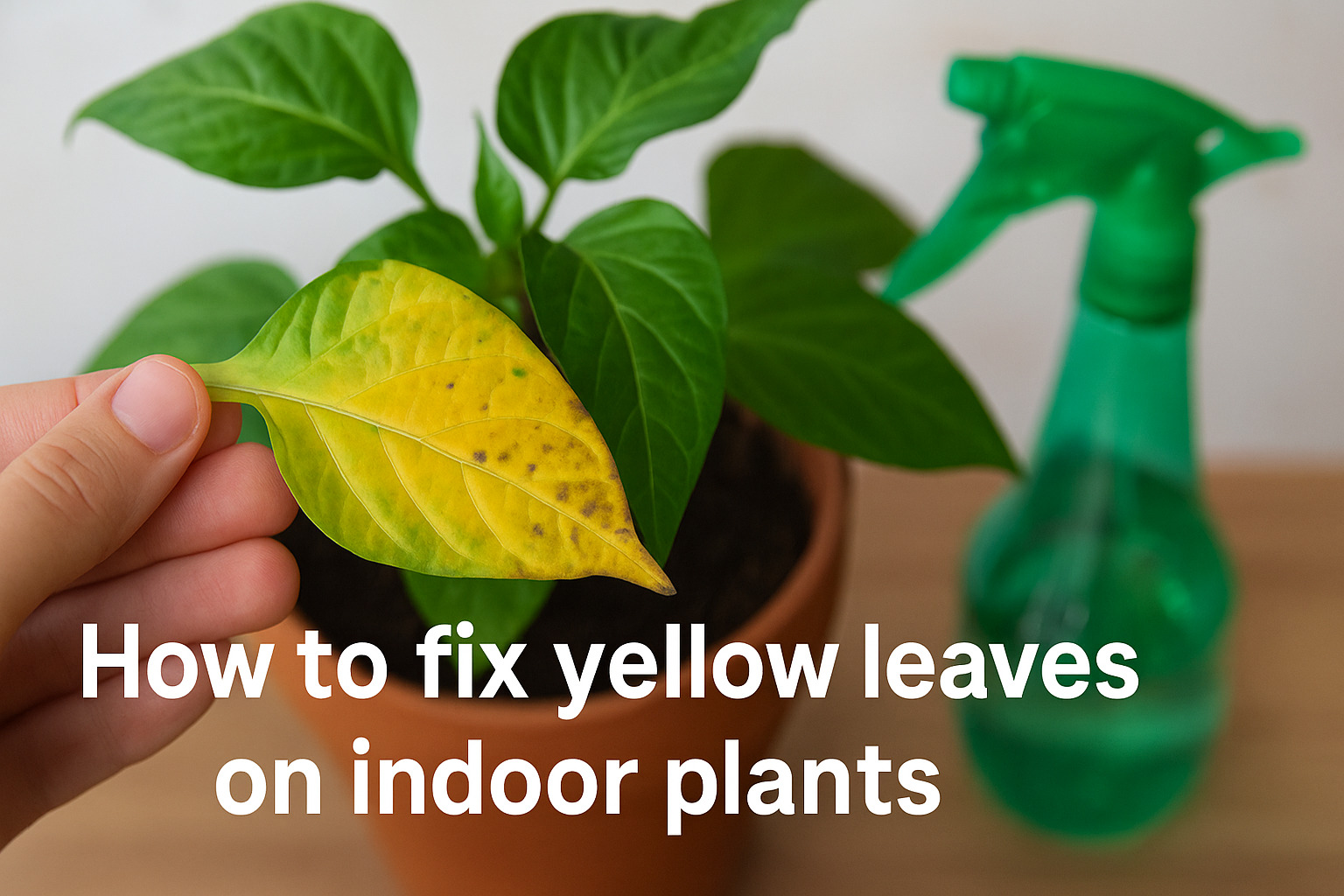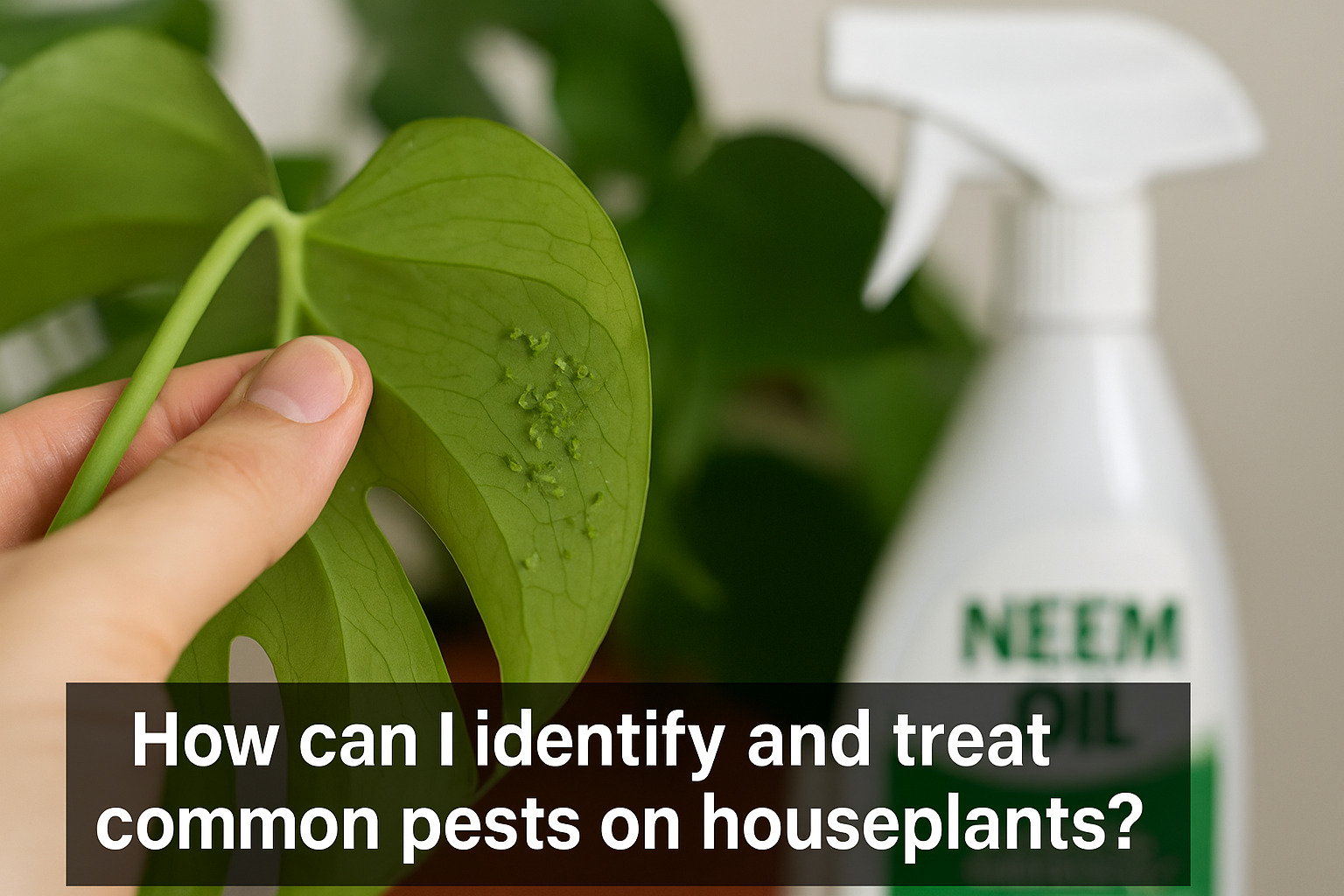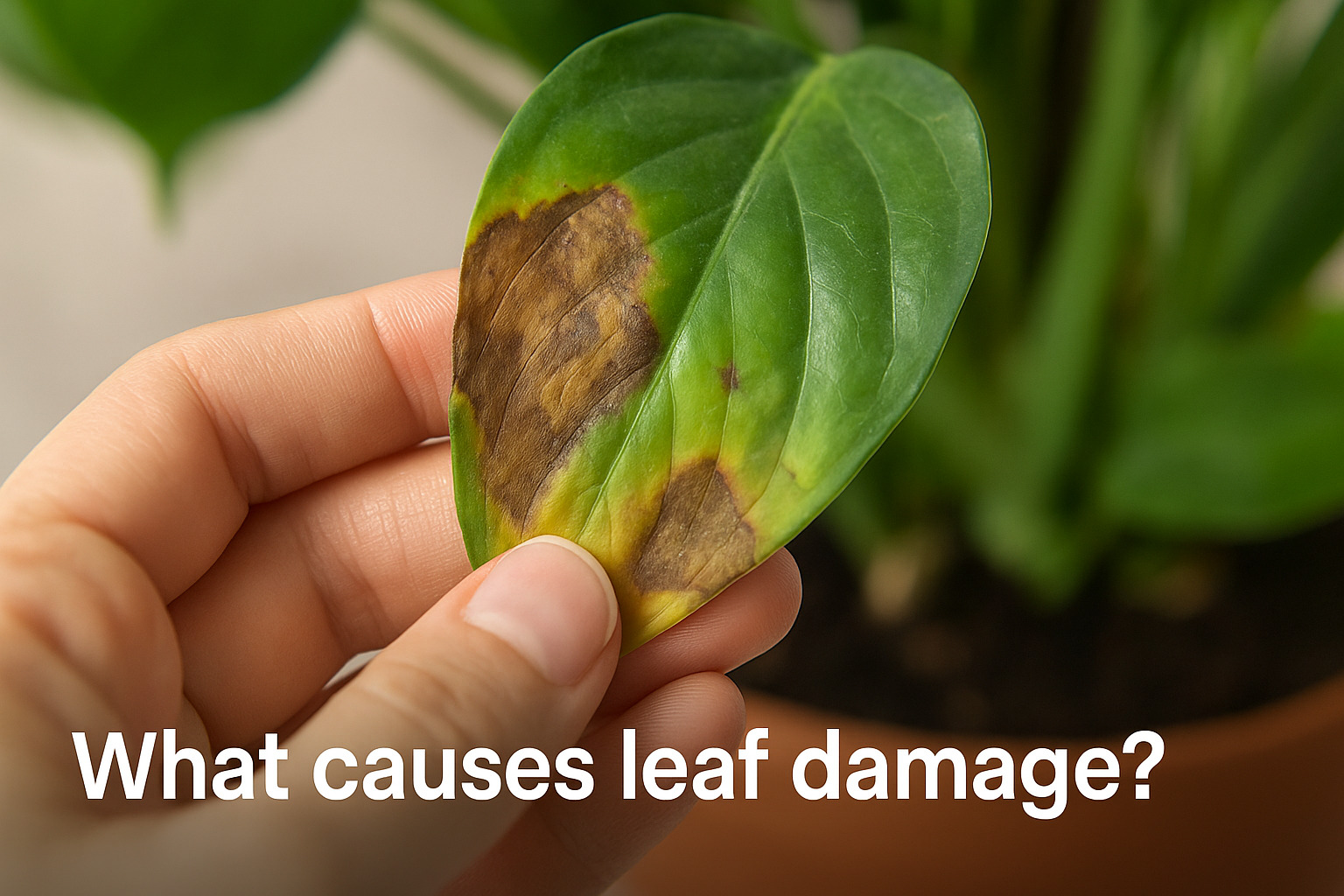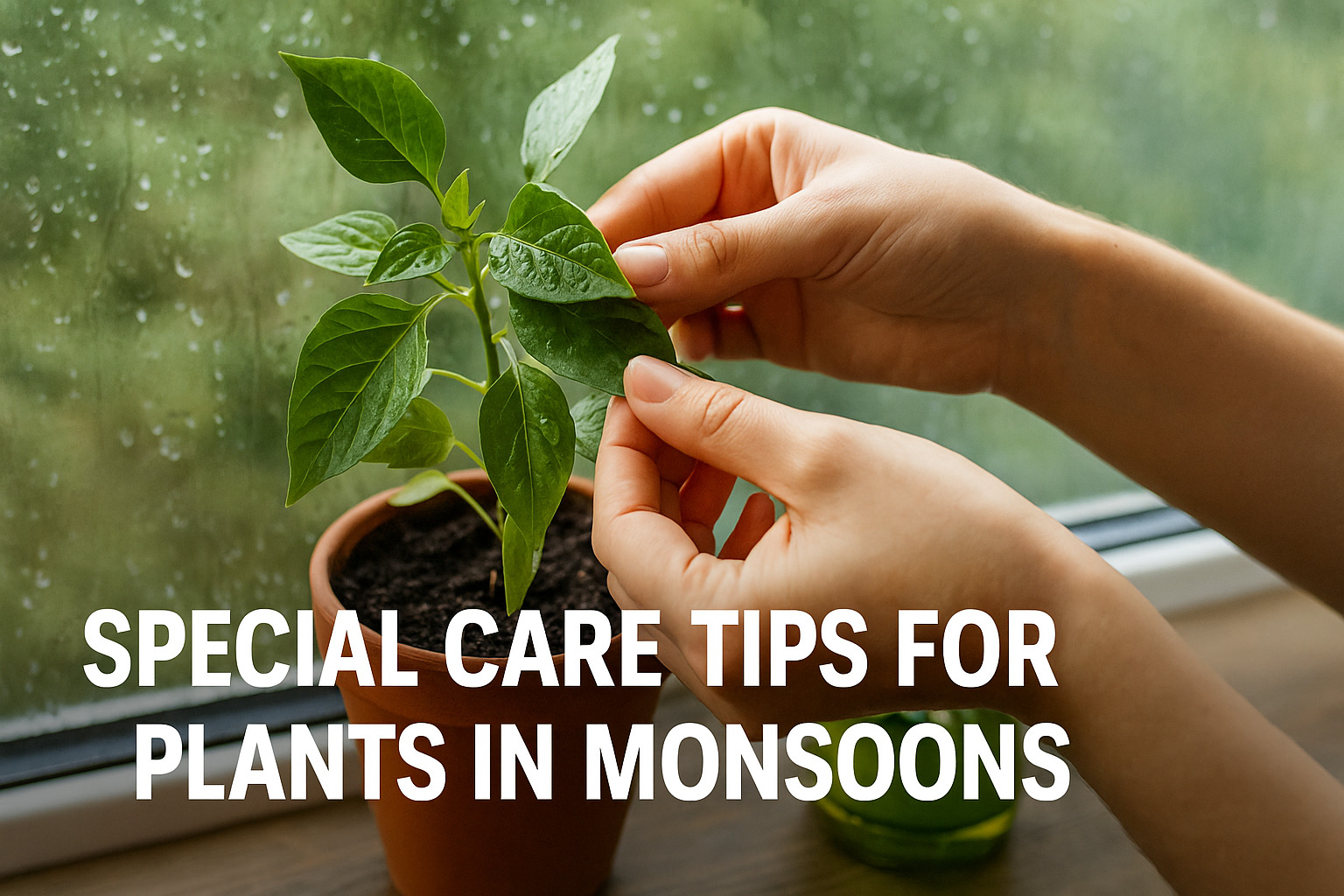_(1).jpg)
Indoor gardening is a rewarding hobby, but even the most diligent plant parent can run into trouble.
From yellow leaves and drooping stems to creepy-crawlies and root rot, indoor plant care problems come in many forms.
In this guide, we’ll cover common houseplant problems and solutions in an expert yet beginner-friendly way.
You’ll learn how to diagnose issues like overwatering, pest infestations, nutrient deficiencies, and more – and how to fix them using organic methods and good gardening practices.
By the end, you’ll have actionable care tips, product recommendations, and expert advice to keep your urban jungle thriving.
Why are my indoor plant leaves turning yellow? How to fix yellow leaves on indoor plants?

Yellow leaves on houseplants are one of the most common complaints.
There are several culprits: overwatering, insufficient light, nutrient deficiencies, or pests. Overwatering is a particularly frequent cause.
In fact, the University of Maryland Extension notes that excess moisture causes “wilting or yellowing of lower and inner leaves”.
If you notice older leaves turning yellow and dropping, check the soil – if it’s soggy, you’ve likely overwatered.
The solution is to let the soil dry out and improve drainage (use pots with holes and well-draining soil).
Other signs of overwatering include yellowing of both old and new leaves at the same time, brown spots in the center of leaves, and even mold on foliage.
If multiple signs appear, trim off any completely yellow or brown leaves (they won’t recover), and water less frequently.
Monitor the pot’s weight or use a moisture meter to only water when the soil is dry half an inch down.
Nutrient deficiencies (often nitrogen) cause generalized yellowing. If you notice yellow leaves despite proper watering and light, feed your plant.
An organic houseplant fertilizer will replenish missing nutrients.
For example, Urban Plant’s organic liquid fertilizer (Care Blend Bio Plant Fertilizer) provides a “balanced mix of essential nutrients that improve plant health”
Finally, check for pests: sap-suckers like aphids or whiteflies can cause leaves to yellow unevenly.
See the next section on pest damage on houseplants below.
Read Also
Nasa-Approved: Top 10 Air-purifying Plants For Your Bedrooms In India
Monsoon Secrets: Care Tips For Balcony Plants In Rainy Season
How can I identify and treat common pests on houseplants (organic pest control)?

Leaf damage and discoloration are often due to insect pests. Look closely on leaf undersides and stems for tiny bugs.
Common houseplant pests include aphids, whiteflies, mealybugs, and spider mites.
For example, Penn State Extension describes aphids as soft-bodied insects on branch tips that distort new growth, and mealybugs as white “cottony” clusters that stunt plants.
Whiteflies appear as tiny white flies; affected plants show “yellowing, reduced vigor, and leaf drop”.
Spider mites (not insects, but mites) create fine webbing and tiny white or bronze spots, eventually causing leaves to drop.
For thorough, organic pest control, use neem oil or insecticidal soap.
These products kill pests on contact and are safe for pets and humans.
For instance, Urban Plant’s Protector MAX Plant Pest Control is an all-natural spray formulated from plant ingredients (similar to neem) that targets aphids, mites, whiteflies, and more.
Apply it by thoroughly coating the leaves (top and underside) every 1-2 weeks until the infestation clears.
Remember: healthy plants fend off pests better. Keep foliage dust-free, avoid overfertilizing, and maintain consistent care.
If needed, repeat organic treatments several times (eggs hatch) until all pests are gone.
What causes leaf damage on houseplants and how to prevent it?

Physical damage or abnormal leaf spots can have various causes. Apart from insects, look for fungal diseases or environmental stress.
Leaf damage on houseplants often shows as brown spots, edges, or holes.
Brown crispy edges usually mean low humidity or over-fertilization. In winter, central heating dries the air: plants may get “brown tips and edges” from dry air.
Brown spots in the middle of leaves often indicate sunburn (too much direct light) or nutrient imbalance.
Check that the plant isn’t against a hot window or heater. If spots spread, trim affected leaves and adjust placement.
Fungal diseases (leaf spots, molds) occur in damp, poorly-ventilated conditions.
As a rule, water only the soil (not leaves), avoid overhead watering, and ensure good air circulation.
If you see fuzzy gray mold on leaves, remove it and use a natural fungicide or homemade baking soda spray.
If you suspect chemicals or salts (from tap water or too much fertilizer), yellow or brown patches may appear.
Flush the soil by watering thoroughly to leach out buildup, and consider using filtered water for sensitive species.
Preventative care is key: keep your plant stress-free. According to Colorado State Extension, “plants that are not vigorously growing and/or are under stress may be particularly susceptible to insect and mite injuries.”
Prune dead or weak branches, repot if roots are crowded, and give your plants fresh soil yearly.
What are the signs of overwatering or underwatering, and what solutions help?
.jpg)
Overwatering signs and solutions: As mentioned, wilting foliage despite wet soil is a red flag.
Other symptoms include yellow or translucent leaves, leaf drop, and a musty smell.
The UMD Extension highlights that “problems with excess water can result from poorly drained soil or overwatering.”
The #1 symptom is wilting or yellowing of lower leave. In severe cases, roots rot and turn black.
If you spot these signs, immediately stop watering.
Let the soil dry out and trim off any rotten roots or collapsed stems. Repot in fresh, well-draining mix if needed.
Improve drainage by adding perlite or moving to a pot with holes.
For prevention, water only when needed: lift the pot to feel its weight as a guide (dry soil is light).
Underwatering signs: Leaves will wilt, curl, or brown around edges.
Soil will pull away from pot edges. If underwatered, the cure is simple: soak the plant until water drains and resume a regular watering schedule.
Be careful not to swing to the opposite extreme—let the soil dry between waterings.
Are there special care tips for plants in monsoons or rainy seasons?

Yes. High humidity and frequent rain (as in monsoons) change plant care. During wet months, reduce watering since rain and humidity keep the soil moist.
Check pots so they don’t sit in standing water: good drainage is critical.
Move sensitive plants under cover or indoors to avoid heavy rain damage.
Damp conditions can foster fungus gnats (tiny flies in soil) and fungal leaf spots.
- Switch to indoor positioning: Even more sheltered spots if storms are heavy.
- Repot or refresh soil: Use a looser mix (with perlite) to improve drainage.
- Fungus prevention: Allow extra air flow around leaves; pinch off any rotting blooms.
- Leaf cleaning: Rain or high humidity can leave mold or dust on leaves. Wipe leaves gently with a wet cloth.
Monitor for pests: extra moisture can bring up bugs from soil or attract slugs outdoors. You might use sticky traps to catch fungus gnats.
Continue using organic pest sprays if needed.
Overall, the mantra is “less water, more airflow” during monsoons.
These care tips for plants in monsoons ensure that excess rain doesn’t drown your plants or invite disease.
Expert Tips and Product Recommendations
.jpg)
- Organic fertilizers: As noted, feed depleted plants with a balanced fertilizer. “Watering with tap water in a hard water area can also lead to deficiencies,” so consider rainwater or filtered water if you have hard tap water. An organic option like Urban Plant’s Fertilizer gives essential nutrients for lush green growth.
- Organic pest control: Neem oil or natural sprays are best. For example, Urban Plant’s Neem Oil uses plant extracts safe for you and insects. Reapply every week or after rain until pests are gone.
- Pruning tools: Use clean, sharp pruners to remove dead or diseased foliage. Urban Plant’s BranchBuddy Pruner is ergonomic and rust-resistant, perfect for cutting brown stems and shaping your greenery.
User-Generated Tip: “I’ve found that letting new plants adjust in a shaded spot for a week before moving them to sun helps prevent shock and yellowing,” suggests one urban gardener.
Another tip is to use the plant’s leaf color as a guide: if new growth is pale green or yellow-tinged, increase light; if only older leaves are yellow, check watering or nutrients.
Expert Quote: Dr. Green Thumb, a horticulture advisor, reminds us that “consistent, moderate care beats sporadic perfection” – meaning regular checks and small adjustments will keep most problems at bay.
Even simple steps like rotating the pot for even light, wiping leaves monthly, and pinching off yellow leaves (which stimulates new growth) make a big difference in plant health.
FAQs
1. What are the most common houseplant problems and how do I fix them?
Common houseplant problems and solutions include yellow leaves (usually caused by overwatering or poor light), pest infestations like mealybugs and spider mites, brown leaf edges from low humidity, and mold due to excess moisture.
You can fix these by adjusting watering schedules, improving drainage, using organic pest control sprays, and ensuring proper humidity and airflow.
2. How do I fix yellow leaves on indoor plants naturally?
To fix yellow leaves on indoor plants, first check for overwatering, poor light, and nutrient deficiencies.
Let soil dry before rewatering, place the plant in bright indirect light, and feed it with an organic nitrogen-rich fertilizer like Urban Plant’s Care Blend. Trim affected leaves to encourage new, healthy growth.
3. What are signs of overwatering in houseplants and what is the solution?
Overwatering signs include yellowing leaves, wilting despite wet soil, mushy stems, fungus gnats, and a musty smell.
Solutions include repotting with better drainage, reducing watering frequency, and using a moisture meter to avoid guessing.
4. What are the best organic pest control solutions for indoor plants?
For pest control organic methods, use neem oil spray, insecticidal soap, or bio-based pest sprays like Urban Plant’s Protector MAX.
These help eliminate common pests like aphids, spider mites, and mealybugs without harming the plant or indoor environment.
5. Why do indoor plant leaves have brown tips and how do I prevent it?
Leaf damage on houseplants such as brown tips often results from low humidity, salt buildup, or tap water chemicals.
Prevent this by using filtered water, increasing room humidity with a humidifier or pebble tray, and flushing the soil monthly to remove salts.
6. What care tips should I follow for indoor plants during the monsoon season?
Care tips for plants in monsoons include reducing watering frequency, ensuring drainage to prevent root rot, avoiding over-fertilization, and watching for fungal growth.
Move sensitive plants indoors or under shelter and clean leaves regularly to prevent mold.
7. How do I know if my houseplant is underwatered vs. overwatered?
Underwatered plants have dry, crispy leaves and very light soil. Overwatered plants show yellow, wilting leaves and soggy soil.
Feel the topsoil or use a stick to check moisture levels. Adjust watering accordingly for balanced indoor plant care.
Conclusion: Healthy Plants = Happy Homes
By recognizing common houseplant problems and implementing these simple, organic solutions, you can maintain thriving indoor plants and transform your space into a vibrant, green sanctuary.
Explore Urban Plant’s specialized indoor plant care solutions to simplify your gardening journey!




